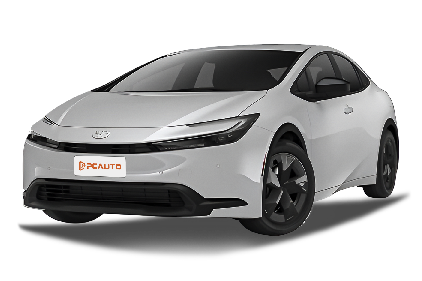Q
How much is the Prius 2023?
In 2023, the prices of the Toyota Prius in Malaysia vary depending on the model and configuration. The starting price of the entry-level Prius 1.8L is around RM 150,000, while the top-spec Prius 1.8L Advanced might cost close to RM 170,000. The specific prices may fluctuate slightly due to dealer promotions or optional packages.
As a classic hybrid model under Toyota, the Prius is well-known for its excellent fuel economy and environmental-friendly performance. The 2023 model has been upgraded in terms of exterior and interior. It adopts a more fashionable design language and more advanced technological features, such as a larger central control screen and a more comprehensive driving assistance system.
For Malaysian consumers, especially those drivers who focus on fuel-saving and environmental protection, the Prius is a great choice. The hybrid technology can significantly reduce fuel consumption in Malaysia's urban traffic environment. Additionally, Toyota has a well-established after-sales service network in Malaysia, providing convenient maintenance and repair support for car owners.
If you're interested in the Prius, it's recommended that you visit a nearby Toyota dealership for a test drive to have a more direct experience of its driving feel and functional features.
Special Disclaimer: This content is published by users and does not represent the views or position of PCauto.
Related Q&A
Q
Can you jump a 2023 Prius?
Yes, the 2023 Toyota Prius can be jump-started to restore power. However, you need to pay attention to some key steps to ensure safety. This vehicle is equipped with a hybrid system. Its 12V auxiliary battery (usually located in the trunk or under the rear seats) is used to start the vehicle's electronic system, not the drive motor. When jump-starting, you first need to find the positive and negative terminals of the 12V battery (some models may have dedicated jump-start points). Use standard jump-start cables to connect to the battery of another vehicle or an external power source. Start the rescue vehicle and maintain its engine speed to charge the battery. Once the Prius dashboard is powered on, you can try to start the car. After the hybrid system starts, it will automatically charge the 12V battery. The hot and humid climate in Malaysia may accelerate battery aging. It is recommended to regularly check the battery status. If the battery frequently runs out of power, it may indicate that the battery life is coming to an end or there is a parasitic discharge problem in the vehicle, and timely maintenance is required. It's worth noting that the 12V battery capacity of hybrid models is usually smaller than that of traditional fuel-powered vehicles. Therefore, they are more susceptible to the impact of long-term parking or leaving the lights on. It is recommended that car owners carry a portable emergency power supply with them to handle unexpected situations.
Q
Is the Prius 2023 self-charging?
Yes, the 2023 Toyota Prius is a "self-charging" Hybrid Electric Vehicle (HEV). It charges its battery through the kinetic energy recovery system during vehicle operation and the engine running, without the need for an external power source to plug in. Specifically, the hybrid system of the Prius converts kinetic energy into electrical energy and stores it in the battery when braking or coasting. Meanwhile, the battery is also charged when the engine is running. Therefore, car owners don't need to charge the vehicle additionally like they do with Plug-in Hybrid Electric Vehicles (PHEVs) or Electric Vehicles (EVs). For users in Malaysia, this design of the Prius is very convenient because the local charging infrastructure may not be as well-developed as in some other countries. The self-charging hybrid vehicle can not only enjoy the energy-saving advantages of electric drive but also avoid the hassle of charging.
In addition, the 2023 Prius performs excellently in terms of fuel economy and emissions, making it very suitable for the urban road conditions in Malaysia, especially in the frequently congested driving environment. It should be noted that although the Prius is a self-charging hybrid vehicle, it cannot travel long distances solely on electricity like a pure electric vehicle. Its electric mode is mainly used for assisting driving and short-distance, low-speed driving.
Q
Do you have to charge the 2023 Prius?
The 2023 Toyota Prius, as a hybrid model, doesn't need to be externally charged like a pure electric vehicle when used in Malaysia. This is because it automatically charges the battery through the kinetic energy recovery system during vehicle operation and the engine's running. This design is highly suitable for Malaysia's driving environment, especially in congested urban traffic, where it can fully demonstrate its energy-saving advantages.
It's worth mentioning that the 2023 Prius actually offers a plug-in hybrid version (Prius Prime). If you choose this version, you need to externally charge it regularly to get a longer pure-electric driving range (about 70 kilometers). This is very practical for daily short-distance commuting and can further reduce fuel consumption.
The Malaysian government currently offers certain tax incentives for hybrid and electric vehicles. So, both the regular hybrid and plug-in hybrid versions are worth considering. Hybrid technology performs stably in tropical climates, and the battery cooling system has been optimized, making it suitable for Malaysia's hot and rainy climate conditions.
If you often drive long distances, the regular hybrid version will be more convenient. However, if you mainly drive in the city and have the conditions for home charging, the plug-in hybrid version will be a more economical and environmentally friendly choice.
Q
How big is the fuel tank on a 2023 Prius?
The fuel tank capacity of the 2023 Toyota Prius is approximately 43 liters. This design balances fuel economy while ensuring sufficient driving range, making it suitable for the daily commuting or long-distance driving needs of Malaysian users. As a representative of hybrid models, the Prius can significantly reduce fuel consumption through its efficient gasoline-electric collaborative system. With a 43-liter fuel tank, it can provide a driving range of about 800 to 900 kilometers under combined driving conditions, which is very suitable for the Malaysian consumer group that faces high oil prices and values environmental protection.
It's worth noting that the fuel tanks of hybrid models are usually smaller than those of pure gasoline vehicles because their electric systems share part of the power demand. Car owners can further optimize fuel consumption by reasonably using the EV all-electric mode. For users who often travel across states, it is recommended to plan the charging routes in combination with the Prius' energy monitoring system. Many shopping malls and gas stations in Malaysia are already equipped with charging facilities, which can fully leverage the energy-saving advantages of hybrid vehicles.
Q
How do I charge my 2023 Prius?
The 2023 Toyota Prius in Malaysia is mainly automatically charged through its hybrid system without the need for external charging. The battery will be automatically charged during driving through brake energy recovery and engine operation, so car owners don't need to take any additional actions. If you're driving the Prius Prime plug-in hybrid version, you can charge it via a household power source or a public charging station. When using household charging, make sure the voltage is stable and a dedicated charging cable is equipped. For public charging, it needs to be compatible with the Type 2 interface. It takes about 2 hours to charge the battery to 80%. It is recommended to regularly check the battery status to ensure its efficiency. Due to the hot climate in Malaysia, it's advisable to avoid long-term exposure to the sun to extend the battery life. Hybrid cars are more fuel-efficient when driving at low speeds in the city, which is suitable for the traffic conditions in Malaysia. For more details on charging, you can refer to the owner's manual or consult a Toyota-authorized service center.
Q
What type of gas does a 2023 Prius take?
The 2023 Toyota Prius in Malaysia is recommended to use RON95 unleaded gasoline. This is the fuel type officially recommended by Toyota for this model, which can ensure the efficient operation of the engine and take fuel economy into account. As a hybrid model, the Prius's Atkinson cycle engine has certain requirements for fuel quality. The octane number of RON95 is suitable for its compression ratio design. Meanwhile, RON95 is widely available at gas stations in Malaysia, making it very convenient to use. It's worth noting that although RON97 has a higher octane number, unless the vehicle specifically requires it, using RON97 won't bring any additional performance or fuel-saving advantages. Instead, it will increase the cost of vehicle use. Car owners in Malaysia also need to pay attention to choosing gas stations with a good reputation to ensure fuel quality and avoid engine carbon deposits or oxygen sensor damage caused by poor-quality gasoline. The maintenance of the battery pack of the hybrid system is also very important. Regular maintenance can extend the battery life. In addition, the hot and humid climate in Malaysia places high demands on the heat dissipation of the hybrid system. It is recommended that car owners regularly check the cooling system as required by the manual.
Q
Does the 2023 Prius have a solar roof?
The 2023 Toyota Prius does offer an optional solar roof configuration in some overseas markets. This technology can use the solar panels on the roof to provide auxiliary charging for the hybrid battery. Meanwhile, it supports powering in-vehicle electrical appliances when the car is parked. However, it should be noted that whether the version introduced in the Malaysian market is equipped with this function should be based on the local Toyota official configuration list.
Solar roof technology has been gradually applied in the new-energy vehicle field in recent years. In addition to Toyota, other brands such as Hyundai and Tesla have also introduced similar designs. Its actual performance is greatly affected by sunlight conditions. In a tropical country like Malaysia, it can theoretically play a better role, but the specific charging efficiency also depends on the area of the photovoltaic panels and the technical solution.
It is recommended that consumers interested in this technology can directly consult Malaysian Toyota dealers to obtain detailed local configurations. At the same time, they can also learn about the adaptation technologies of new-energy vehicles from other brands in tropical climates, such as battery cooling systems or high-temperature protection designs. All these can help better maintain electric and hybrid vehicles in Malaysia's hot and humid environment.
Q
Does a Prius 2023 have a transmission?
The 2023 Toyota Prius is indeed equipped with a transmission system. However, it uses Toyota's unique Electronic Continuously Variable Transmission (ECVT), which is fundamentally different from the mechanical gearboxes of traditional fuel-powered vehicles. The ECVT achieves power distribution through the coordinated operation of the electric motor and the planetary gear set. It doesn't have the fixed gears of a traditional gearbox, so the driving experience is smoother and more efficient. This design is one of the cores of hybrid vehicles, which can intelligently switch between electric-motor drive, engine drive, or hybrid drive modes according to driving conditions, significantly improving fuel economy.
For users in Malaysia, the Prius' ECVT system performs exceptionally well in congested urban roads. It not only reduces the jerks caused by frequent gear-shifting but also lowers fuel consumption through energy recovery. It should be noted that the key points for maintaining a hybrid vehicle lie in the battery pack and the electronic control system. It is recommended to have regular inspections at an authorized service center to ensure the long-term stable operation of the system. Compared with traditional gearboxes, the ECVT has a simpler structure and a lower failure rate. However, if any abnormalities occur, professional technicians with specialized equipment are still required for diagnosis. Other brands, such as Honda's hybrid models, also use similar technologies, but the specific implementation methods have their own characteristics.
Q
Is 2023 Prius AWD or FWD?
The 2023 Toyota Prius is available in two drivetrain versions in the Malaysian market: Front-Wheel Drive (FWD) and All-Wheel Drive (AWD). Consumers can choose according to their needs. The AWD version achieves four-wheel drive functionality through a rear-mounted motor, enhancing stability on slippery roads. On the other hand, the FWD version focuses more on fuel economy. Given Malaysia's rainy climate, the AWD system can improve driving safety in rainy weather. However, the FWD version, with its simple structure and lighter weight, is also highly efficient for daily city driving. As a hybrid model, the drivetrain choice of the Prius doesn't affect its low fuel consumption advantage. All models are equipped with a 2.0L hybrid system, with a significantly improved combined power output while maintaining the reliability that Toyota hybrids are known for. When Malaysian consumers are choosing a car, they can weigh the road conditions and their budgets. If they often encounter rough roads or travel in rainy days, the AWD version is more practical. If their driving is mainly for city commuting, the FWD version offers better cost - effectiveness. Additionally, the 2023 Prius has also been upgraded in terms of chassis and design, with a lower drag coefficient, more appealing handling, and a better - looking exterior, making it suitable for local users who value environmental protection and technology.
Q
Does the 2023 Prius have four doors?
In 2023, the Toyota Prius indeed features a four-door design, continuing its positioning as a practical hybrid family car. The five-seat layout and the structure that facilitates rear-seat passengers getting on and off are highly suitable for the daily use of Malaysian families or urban commuting. This fifth-generation model is built on the TNGA-C platform. The car body is lower and the wheelbase is longer. The opening angle of the rear door reaches 80 degrees, which is relatively large in its class, making it convenient to install child safety seats or carry items.
It's worth mentioning that the 2023 Prius offers two hybrid system options, 1.8L and 2.0L, in the Malaysian market. The 2.0L version has a combined power of up to 193 horsepower, being the most powerful performance version in all generations, while maintaining excellent fuel economy. The vehicle is also equipped with the latest Toyota Safety Sense system, including a pre-collision system and full-speed range adaptive cruise control, which is particularly suitable for the complex urban road conditions in Malaysia.
As the world's best-selling hybrid model, the battery stability of the Prius in tropical climates has also been specially optimized. Malaysian car owners don't need to worry about the impact of high temperatures on the hybrid system.
Latest Q&A
Q
How to reset the tire pressure sensor in Honda Civic?
To reset the TPMS on your Honda Civic, start by turning the ignition to the "on" position without starting the engine. Then, locate the "TPMS" button on the dashboard or navigate to the vehicle settings menu via the infotainment screen. Select the "Tire Pressure Calibration" option and follow the prompts to complete the reset. Afterward, drive normally for about 10 minutes to let the system automatically learn the new tire pressure data.
It's worth noting that the process can vary slightly between Civic model years. Newer models might offer touchscreen controls, while older ones may require using the steering wheel buttons to cycle through menus. For Malaysian owners, given the hot climate, it's a good idea to check your tire pressure—including the spare—once a month. High temperatures can cause pressure to rise, and improper tire pressure doesn't just hurt fuel economy and handling; it can also speed up tire wear.
If the TPMS light stays on after resetting, the sensor battery might be dead or you could have a slow leak. In that case, it's best to head to a professional workshop for further diagnosis. Also, TPMS sensor batteries typically last 5-7 years, and when replacing them, sticking with OEM parts is recommended to ensure compatibility.
Q
How much is a Honda Civic 2024
The 2024 Honda Civic's pricing in Malaysia varies depending on the trim level and specs, typically ranging from around RM130,000 to RM160,000. For the most up-to-date figures and any ongoing promotions, your best bet is to hit up your local authorized Honda dealer.
As a Honda staple, the Civic has long been a favorite among Malaysian drivers, thanks to its solid reliability, sleek looks, and tech-forward features. The 2024 model steps things up even more in the safety and driver assistance department—expect it to come equipped with the Honda Sensing suite, which includes handy features like adaptive cruise control and lane-keeping assist.
Another big plus for the Civic in Malaysia? Its fuel efficiency and wallet-friendly maintenance costs. If you're in the market for a compact sedan, this one's definitely worth a spot on your shortlist. Of course, it's not without competition—rivals like the Toyota Corolla and Mazda 3 are also vying for attention. At the end of the day, it all comes down to your personal taste and budget, so take the time to compare them side by side.
Q
Which tyre brand is the best for Honda Civic?
When it comes to picking the right tires for your Honda Civic in Malaysia, you’ve got to factor in our local road conditions, climate, and your driving style. The Michelin Pilot Sport 4 or Primacy 4 lines are solid go-tos—they strike a nice balance between dry and wet grip, durability, and noise levels, matching the Civic’s sporty character pretty well. If comfort and long mileage are your top priorities, especially for those frequent highway runs, the Bridgestone Turanza T005A leans more that way. On a tighter budget? The Continental UC6 or Goodyear Assurance TripleMax 2 still deliver reliable daily driving performance with better value for money.
Since Malaysia gets a fair amount of rain, prioritizing tires with high wet performance ratings (like an A rating on the EU label) is smart. Also, make sure the size matches your factory specs—common ones are 215/50 R17 or 225/45 R18. Keeping an eye on tire pressure (around 230-240 kPa) and checking tread wear regularly will help them last longer. If you often hit rough roads, consider models with reinforced sidewalls, though they might nudge fuel consumption up a tiny bit.
Q
How to update the satellite navigation system of Honda Civic ?
To update the satellite navigation system in your Honda Civic, first you need to confirm your car's model year and navigation system version, since different model years might use different update methods. For newer Honda Civics, you can get the latest navigation map update package from the official Honda Malaysia website or an authorized dealership. Usually, you'll need to download it to a USB drive and then plug that into your car's USB port to install. If you have an older model, you might have to head to a dealership where they can do the update using special equipment. It's a good idea to back up your existing data before updating and make sure your car battery is fully charged to avoid any interruptions. Also, updating your navigation system regularly not only gets you the latest road info but also boosts system performance—like faster route calculations and more accurate real-time traffic data. If you're not sure how to do the update yourself, it's best to contact Honda Malaysia's customer service or book an appointment with a dealership to help out, so the update goes smoothly. In the meantime, you could also use smartphone navigation apps like Waze or Google Maps as a temporary alternative—they usually offer real-time updates and more features anyway.
Q
What engine does a 2015 Honda Civic have?
The 2015 Honda Civic in Malaysia came with two engine options: a 1.8-liter SOHC i-VTEC four-cylinder naturally aspirated unit and a 2.0-liter SOHC i-VTEC four-cylinder naturally aspirated engine. The 1.8L puts out 141 horsepower and 174 Nm of torque, while the 2.0L ups the ante to 155 hp and 190 Nm. Both are paired with a 5-speed automatic transmission, delivering smooth driving dynamics and solid fuel efficiency.
What really stands out is Honda's i-VTEC tech – it smartly adjusts valve timing and lift to optimize performance and efficiency across different engine speeds, making it perfect for Malaysia's mix of city commutes and highway runs. The 2015 Civic also built a strong reputation locally for being durable and easy on maintenance costs. Honda clearly thought about our tropical climate too – the engine's cooling system and electronics are tweaked to handle the heat and humidity, ensuring reliable operation even when things get sweltering.
For Malaysian buyers, the 2015 Civic's engines offer more than enough power for daily driving, and their long-term running costs are pretty reasonable. No wonder it's still a hot pick in the used car market.
View MoreRelated News

The Tiggo 7 PHEV, conversely, gains traction among younger buyers by offering a lower price point and a more technologically advanced package.
JamesOct 15, 2025

Toyota announced that the earliest mass production of solid-state batteries will be in 2027, and has currently developed highly durable cathode materials.
MichaelOct 13, 2025

Suzuki Fronx vs. Toyota Yaris Cross comparison, which one is more worth buying?
LienOct 5, 2025

Toyota Mystery Project teaser sparks speculation, Akio Toyoda personally involved in teaser process
JamesOct 2, 2025

Rumor: Toyota and Mazda collaborate to develop the next-generation MX-5 and GR86
AshleySep 30, 2025
View More


















Pros
Cons